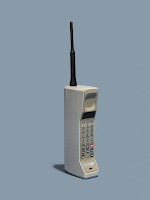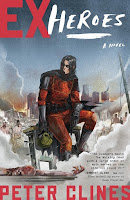I know the A2Q thing just got started, but I wanted to pause for a few moments to talk about action.
I’m a big believer that action—especially dynamic action–shouldn’t take much longer to read than it would take to happen. Swordfights, shootouts, fistfights, even sex scenes—all of these are events where we kind of expect people to get caught up in the moment and not focus too much on minutiae. When I’m telling these events as part of a story, it creates an odd situation where I want to advance the action, but I also need to explain what’s going on. It’s especially tough in first person narratives, but really it can happen anywhere.
 An example I’ve used before is when a ninja leaps out of the shadows to attack me. On the one hand, I want to mention the mask and the gloves and the sash belt and those special shoes that ninjas wear. Plus maybe they’ve got weapons in their hands or tucked in their belt or strapped to their back. Maybe even cursed weapons with extra barbs or weird auras. And wait… is that long red hair? Is this ninja a woman? Holy crap, the robes are kinda loose but, yeah, I think she is.
An example I’ve used before is when a ninja leaps out of the shadows to attack me. On the one hand, I want to mention the mask and the gloves and the sash belt and those special shoes that ninjas wear. Plus maybe they’ve got weapons in their hands or tucked in their belt or strapped to their back. Maybe even cursed weapons with extra barbs or weird auras. And wait… is that long red hair? Is this ninja a woman? Holy crap, the robes are kinda loose but, yeah, I think she is.
Of course, during all this time… what’s the ninja doing? They leaped out of the shadows and… froze in the air? Are they waiting to punch or kick or maybe skewer me with their short sword or something like that?
Heck, did you even remember the ninja was in the process of attacking me while you read through all that description?
Which is the problem in these situations. Once I’m in an action moment, I’ve got to be careful about bringing it to a pause for descriptions of other characters, weapons, fighting techniques, heck sometimes even overly-describing the action itself. I can blow the rhythm and wreck the flow, knocking my readers out of the story right when I want them desperately turning pages.
And it’s not just descriptions that can do this. Another thing I’ve seen is people trying to do funny, snarky dialogue in the middle of action sequences. Sure, this can work to an extent, but when every other character is making one or two quips during every gunfight or car chase or building collapse, these events begin to stretch out. It doesn’t take long for them to start dragging.
Another common one is the sudden need to share information, either between characters or sometimes the narration relaying these facts directly to us, the audience. I think a lot of the time when this happens it’s the writer feeling the sudden need to remind the readers of something important. The potential double whammy here is this can be breaking the flow of my action and it may just be a bunch of noise that we already know and don’t need to be reminded of at this crucial moment.
 The worst of all of these has to be the introspective moment. That point when the arrows are flying and plasma bolts are crashing around us and my character pauses to dwell on how fragile the connections are between all of us, and the series of decisions that unknowingly brought him to this moment. And this place. Of all the possible places he could’ve been right now. One different choice and maybe he’d be on a date with that cute barista, instead of here, pondering the threads of destiny…
The worst of all of these has to be the introspective moment. That point when the arrows are flying and plasma bolts are crashing around us and my character pauses to dwell on how fragile the connections are between all of us, and the series of decisions that unknowingly brought him to this moment. And this place. Of all the possible places he could’ve been right now. One different choice and maybe he’d be on a date with that cute barista, instead of here, pondering the threads of destiny…
Anyway, where were we. Right! Raw plasma exploding everywhere and whoa when did Wakko get fried? How’d I miss that?
Other popular introspective topics that can disrupt action may involve lost loves, found loves, children, aging parents, the ephemeral nature of beauty, and a single raindrop, frozen in that moment of impact that so perfectly symbolizes the inevitability of death…
The real killer for all of this? Lots of stuff counts as action. There’ve been a few times I’ve mentioned that often-misunderstood chestnut, start with action. It doesn’t mean my book needs to begin with a ninja leaping from the shadows, it just means I need to start with something happening. With my characters doing something. Anything. And all those things that count as action are things I want to be careful about disrupting and slowing down.
Now, yeah, of course, there’s always going to be exceptions. There are lots of reasons why my character might have an unusual, unrelated thought in a moment of peak action, or why they might get distracted by that single raindrop. But I need to remember that exceptions are rare.
So don’t break the flow of your story by letting your action get bogged down.
 And speaking of action and doing things… have I mentioned that my new book, Terminus, comes out next week? Like, one week from today. It’s an Audible exclusive, and if you wanted to preorder it now that’d help further convince the people who pay me that my books are a good investment. Which mean more books down the line. Which means we all win.
And speaking of action and doing things… have I mentioned that my new book, Terminus, comes out next week? Like, one week from today. It’s an Audible exclusive, and if you wanted to preorder it now that’d help further convince the people who pay me that my books are a good investment. Which mean more books down the line. Which means we all win.
Next time here on the ranty blog, we continue with the next part of the A2Q, where I’m going to try to explain plots and how to put one together.
Until then, go write.










